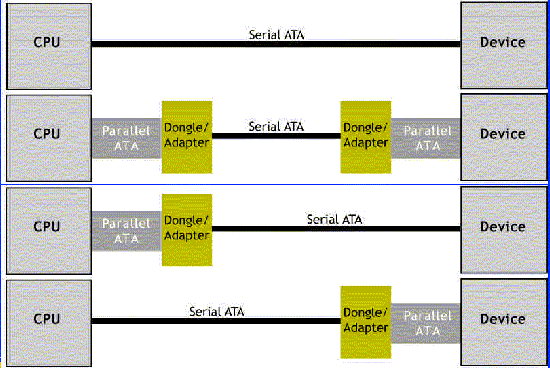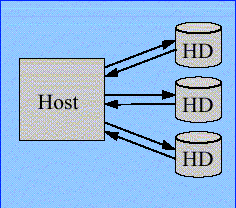Intel IDF Report #2 - Serial ATA & USB 2.0
by Mike Andrawes on February 16, 2000 12:53 PM EST- Posted in
- Trade Shows
On the hardware side, conversion devices will initially provide backward compatibility. The devices will convert a Parallel ATA signal from the motherboard to a Serial ATA signal usable by a new hard drive, or vice versa as needed.

 The future of Serial ATA is being insured with
careful planning. In fact, Serial ATA is expected to last us at least 10 years.
Future data rates may be introduced simply by increasing the clock. In fact the
roadmap already calls for two follow-ups to Serial ATA, which will double and
then double again the transfer rates. Look for Serial ATA 1X to be available in
mid 2001 and offer 1.5 gigabits/sec, which translates to an effective 150MB/s.
Since Serial ATA will be a point to point protocol, the concept of master/slave
no longer exists and each drive will not need to share bandwidth.
The future of Serial ATA is being insured with
careful planning. In fact, Serial ATA is expected to last us at least 10 years.
Future data rates may be introduced simply by increasing the clock. In fact the
roadmap already calls for two follow-ups to Serial ATA, which will double and
then double again the transfer rates. Look for Serial ATA 1X to be available in
mid 2001 and offer 1.5 gigabits/sec, which translates to an effective 150MB/s.
Since Serial ATA will be a point to point protocol, the concept of master/slave
no longer exists and each drive will not need to share bandwidth.
Further, unlike the original Parallel ATA spec, Serial ATA is being designed with power management and mobility in mind. With fewer signals in the interface, power consumption is lower. Further, the interface and drive supports native power management that is transparent to the rest of the system. Finally, the connector for 3.5” and 2.5” drives will be identical, which will greatly increase flexibility of mobile and desktop designs.
The group working on Serial ATA features a number of big names, such as Intel, IBM, Maxtor, Seagate, Western Digital, Quantum, Dell, and more. They’ve made it clear that they’re focused on providing a Parallel ATA replacement without adding too many bells and whistles to weigh down the specification and increase the cost of implementation. So don’t expect to use Serial ATA for scanners, printers, etc. that’s what USB and other external interfaces are for.
With that said, they are designing in at least a few advanced features. At least one that is likely to make the spec, although it may be optional, is hot plug support. The opportunity is even there to power drives through the interface cable, which further simplifies configuration. These two features may not be available at launch, but look for it to happen eventually.
Yesterday at IDF, we got to see a demo of Serial ATA in action. Since chipsets and hard drives that support the interface are not yet available, they used the above mentioned converters from a Parallel ATA interface on the motherboard, to a Serial ATA cable, and finally converted back to a Parallel ATA interface on the drive. The demo was simply and consisted of a script that ran a number of Microsoft Office apps.










0 Comments
View All Comments